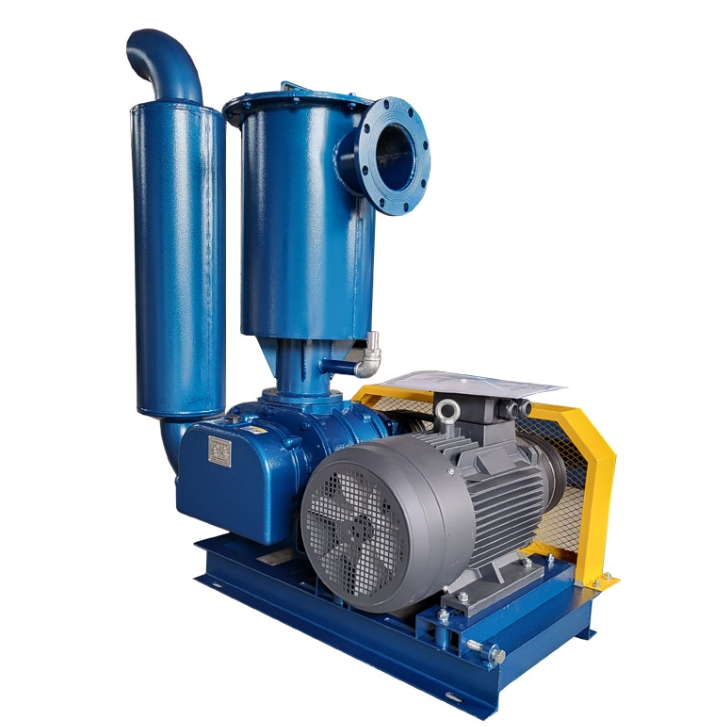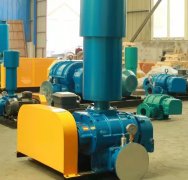Working principle and application of vacuum Roots blower
Vacuum Roots blower, also known as Roots blower or Roots blower, is an important positive displacement fan with wide applications in multiple industrial fields. The following is a detailed introduction to its working principle and application:
1、 Working principle
The working principle of a vacuum Roots blower is mainly based on the relative motion of two blade rotors (usually three bladed impellers) in the cylinder to compress and transport gas. Its working principle can be summarized as the following steps:
1. Rotor rotation: When the motor drives one of the rotors to rotate, the other rotor will rotate synchronously at the same speed and in the opposite direction through the action of the synchronous gear.
2. Gas inhalation: Due to the gaps between rotors and rotors, as well as between rotors and cylinders, a vacuum state is formed at the intake port during the rotation of the rotor, thereby inhaling gas.
3. Gas compression: As the rotor continues to rotate, a sealed working volume is formed between the blades of each rotor and the cylinder wall. This working volume gradually decreases during the rotation of the rotor, thereby achieving compression of the gas.
4. Gas discharge: When the working volume is reduced to a certain extent, it is connected to the exhaust port, and at this time, high-pressure gas flows back, causing the pressure in the working volume to suddenly increase, thereby discharging the gas.
2、 Main features
The vacuum Roots blower has the following main characteristics:
1. Simple structure: Its design is simple, manufacturing is convenient, and maintenance is easy.
2. Stable flow rate: When adjusted within the allowable pressure range, the flow rate changes very little and has the characteristic of forced gas transmission.
3. Pure conveying medium: Due to the tightly controlled gaps between rotors and between rotors and cylinders, the discharged gas is not contaminated by lubricating oil.
4. High noise: Due to periodic suction, exhaust, and instantaneous isochoric compression causing fluctuations in airflow velocity and pressure, significant aerodynamic noise is generated.
3、 Application Fields
Vacuum Roots blowers have a wide range of applications in various industrial fields, mainly including the following aspects:
1. Wastewater treatment: Roots blowers are widely used in aeration systems during wastewater treatment, injecting gas into the aeration tank to promote biodegradation and oxidation processes in wastewater.
2. Pharmaceutical and chemical industries: In the pharmaceutical and chemical industries, Roots blowers can be used for operations such as transporting gases, mixing gases, and suctioning. In addition, it can provide stable airflow for drying, mixing, and conveying materials such as powders and particles.
3. Food processing: Roots blowers are commonly used in food processing for dehydration, drying, cooling, and other processes to assist in the processing of food and its raw materials.
4. Printing industry: During the printing process, Roots blowers can provide stable airflow to help dry printed materials.
5. Petroleum and gas industry: Roots blowers can be used to provide pressure or vacuum for refining, oil and gas transportation and processing, compressed gas and other processes.
6. Environmental protection and purification: In terms of exhaust gas treatment, Roots blowers can be used to adsorb exhaust gas or purify emitted gases, which helps improve environmental quality. In addition, it is also used in the fields of dust removal and air purification for vacuuming, dust removal, and filtration operations, reducing the content of particulate matter in the air.
7. Aquaculture: Roots blowers play an important role in aquaculture, used for oxygenation, increasing dissolved oxygen content in water, and promoting the growth of aquatic organisms.
In addition, vacuum Roots blowers are also used in various fields such as cement conveying, mining, quarrying, mineral processing, and grain processing.
In summary, vacuum Roots blowers play an important role in multiple industrial fields due to their unique working principles and wide application areas. During use, attention should be paid to its usage conditions and regular maintenance should be carried out to ensure its long-term stable operation.



